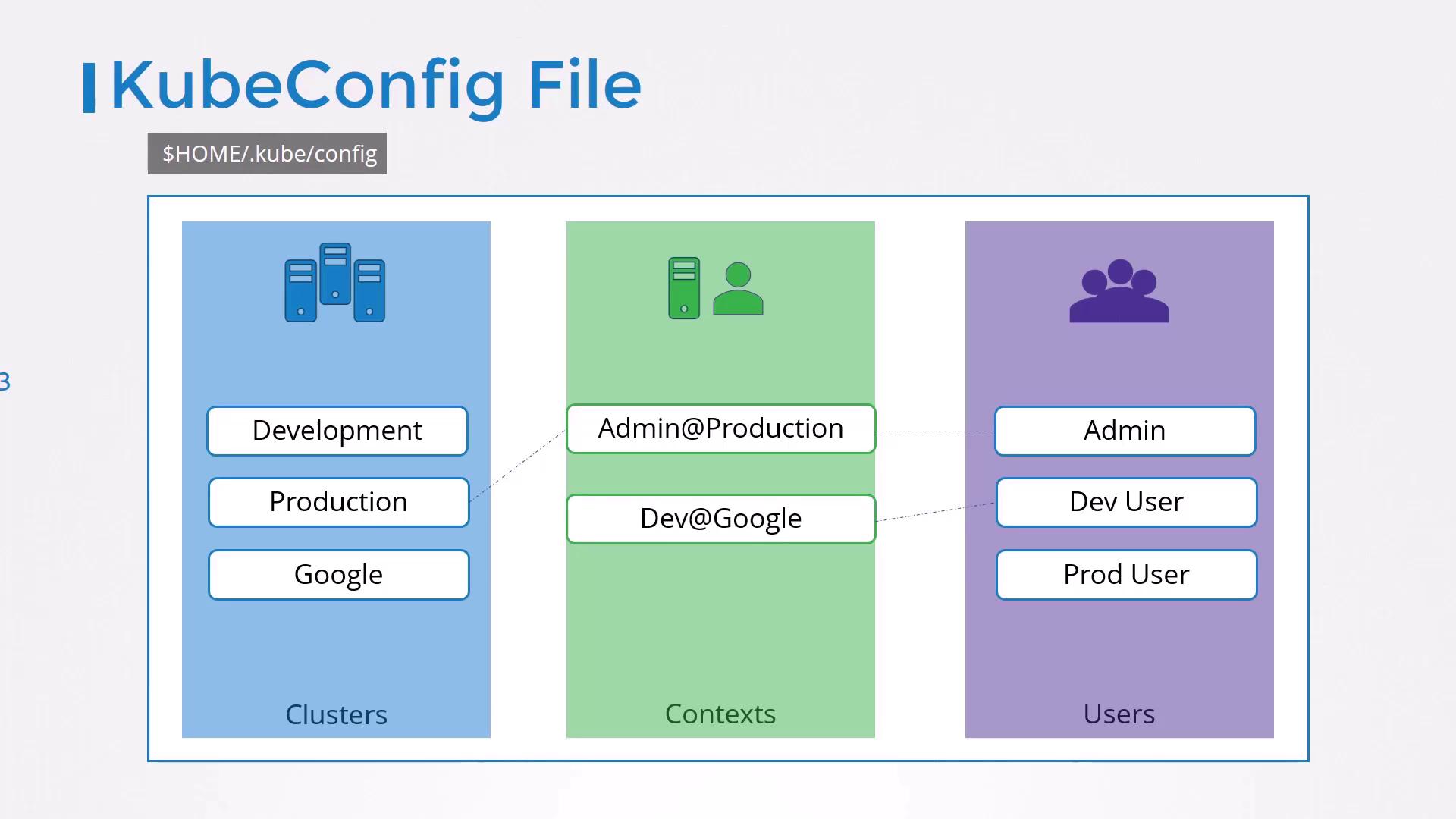Kubernetes and Cloud Native Security Associate (KCSA)
Kubernetes Cluster Component Security
Client Security kubeconfig
In this lesson, we’ll explore how Kubernetes kubeconfig files let you store cluster endpoints and user credentials for kubectl, eliminating the need to retype flags every time you interact with your cluster.
1. Direct API Access with curl
If your API server is at my-kube-playground:6443 and you’ve generated:
- CA certificate:
ca.crt - Client certificate:
admin.crt - Client key:
admin.key
You can query the API directly:
curl https://my-kube-playground:6443/api/v1/pods \
--key admin.key \
--cert admin.crt \
--cacert ca.crt
Response:
{
"kind": "PodList",
"apiVersion": "v1",
"metadata": {
"selfLink": "/api/v1/pods"
},
"items": []
}
2. Equivalent kubectl Commands
With kubectl, the same request requires these flags:
kubectl get pods \
--server https://my-kube-playground:6443 \
--client-key admin.key \
--client-certificate admin.crt \
--certificate-authority ca.crt
Output:
No resources found.
Typing long flag lists is tedious. Let’s streamline this with a kubeconfig file.
Note
By default, kubectl looks for ~/.kube/config. You can override with --kubeconfig=PATH.
3. Creating and Using a kubeconfig File
Save your cluster, user, and context definitions in a YAML file (e.g., config), then run:
kubectl get pods --kubeconfig=config
# Or, if you place it at ~/.kube/config:
kubectl get pods
Both commands will yield:
No resources found.
4. Structure of a kubeconfig File
A kubeconfig has three top-level sections:
| Section | Description |
|---|---|
| clusters | Definitions of Kubernetes clusters (name, server URL, CA info) |
| users | Credentials (client cert/key or token) for each user |
| contexts | Mappings of user ↔ cluster, with optional namespace setting |

4.1 Minimal Example
apiVersion: v1
kind: Config
clusters:
- name: my-kube-playground
cluster:
server: https://my-kube-playground:6443
certificate-authority: ca.crt
users:
- name: my-kube-admin
user:
client-certificate: admin.crt
client-key: admin.key
contexts:
- name: my-kube-admin@my-kube-playground
context:
cluster: my-kube-playground
user: my-kube-admin
current-context: my-kube-admin@my-kube-playground
5. Managing Multiple Clusters, Users, and Contexts
You can add as many entries as needed:
apiVersion: v1
kind: Config
clusters:
- name: my-kube-playground
cluster:
server: https://my-kube-playground:6443
certificate-authority: ca.crt
- name: development
cluster:
server: https://dev.example.com:6443
certificate-authority: dev-ca.crt
- name: production
cluster:
server: https://prod.example.com:6443
certificate-authority: prod-ca.crt
users:
- name: my-kube-admin
user:
client-certificate: admin.crt
client-key: admin.key
- name: dev-user
user:
client-certificate: dev.crt
client-key: dev.key
- name: prod-user
user:
client-certificate: prod.crt
client-key: prod.key
contexts:
- name: my-kube-admin@my-kube-playground
context:
cluster: my-kube-playground
user: my-kube-admin
- name: dev-user@development
context:
cluster: development
user: dev-user
- name: prod-user@production
context:
cluster: production
user: prod-user
current-context: my-kube-admin@my-kube-playground
5.1 Viewing and Switching Contexts
Use built-in commands to inspect or switch contexts:
| Command | Description |
|---|---|
kubectl config view | Show merged config (defaults + overrides) |
kubectl --kubeconfig=my-config config view | View a specific file |
kubectl config use-context prod-user@production | Switch current context to production |
6. Setting a Default Namespace
Embed namespace in the context to avoid adding -n on every command:
contexts:
- name: admin@production
context:
cluster: production
user: admin
namespace: finance
Now kubectl get pods under this context defaults to the finance namespace.
7. Embedding Certificate Data Directly
Inline your certs and keys as base64 to avoid external files:
clusters:
- name: production
cluster:
server: https://172.17.0.51:6443
certificate-authority-data: |
LS0tLS1CRUdJTiBDRVJUSUZJQ0FURS0tLS0tCk1JSUNXREND...
users:
- name: admin
user:
client-certificate-data: |
LS0tLS1CRUdJTiBDRVJUSUZJQ0FURS0tLS0tCk1JSUJXREND...
client-key-data: |
LS0tLS1CRUdJTiBSU0EgUFJJVkFURSBLRVktLS0tLQo...
Generate and inspect base64 fields:
# Encode files
cat ca.crt | base64
cat admin.crt | base64
cat admin.key | base64
# Decode embedded data
echo "LS0tLS1CRUdJTiBDRVJUSUZJQ0FURS0tLS0t" | base64 --decode
Warning
Embedding secrets directly in your config can increase exposure risk. Always secure your files and consider encryption at rest.
8. Practice Exercises
- Create a second context for a staging cluster.
- Switch between contexts without retyping server flags.
- Embed certificates and verify connectivity.
- Troubleshoot an invalid certificate scenario.
Links and References
Watch Video
Watch video content
Practice Lab
Practice lab